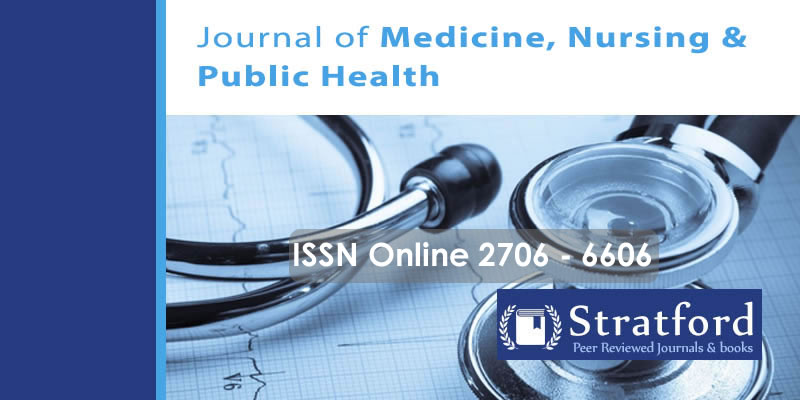Factors Associated With Utilisation of 4th Postnatal Care among Mothers Seeking Vaccination for Children in Selected Health Facilities in the City of Kigali, Rwanda
DOI:
https://doi.org/10.53819/81018102t4187Abstract
Maternal mortality remains a global public health concern. Maternal mortality rate was 211deaths per 100,000 live births in 2017 with sub-Saharan Africa accounting for two third. A strengthened postnatal care can significantly reduce this unacceptable mortality. This study aims at assessing the factors associated with the utilization of 4th postnatal care services among mothers seeking vaccination for their children in selected health centers located in the city of Kigali. A cross-sectional study design was conducted in 10 health centers and 403 mothers were recruited. Data was collected using an interview-administered questionnaire, Chi-square and multivariate analysis were used to examine the relationship between independent variables and PNC4 attendance. Mothers who participated in the study (56.7%) were between the ages of 26 and 35, 47.6% were cohabiting, and 49.6% had completed secondary and TVET school. The attendance of PNC4 was 27%. PNC4 service awareness (AOR = 10.922, 95% CI: 5.869-20.325, P 0.001), ANC attendance (AOR = 2.334, 95% CI, 1.050-5.188, P = 0.038), and religion belief (AOR=0.338, 95% CI, 0.177-0.645, P=0.001) were significantly associated with PNC4 attendance. The utilisation of PNC4 is still low. PNC4 should be strengthened to ensure the well-being of the mothers and children.
Keywords: Postnatal care, Vaccination for Children, utilization, Selected Health facilities, Kigali, Rwanda
References
Tessema, T., Yazachew,, L., Tesema, G., & Teshale , A. (2020, November). Determinants of postnatal care utilization in sub-Saharan Africa: a meta and multilevel analysis of data from 36 sub-Saharan countries. Italian Journal of Pediatrics, 46(175).
(NISR), N. I. (May, 2019). The Rwanda Vital Statistics Report 2019. National Institute of Statistics in Rwanda.
(UNSD), U. N. (2021). The Sustainable Development Goals Report 2021. Extended Report, WHO.
Boerma, T., Requejo, J., & Victora, C. (2017). Countdown to 2030: tracking progress towards universal coverage for women's, children's and adolescents' health. Washington DC: WHO and UNICEF.
Chhetri, S., Shah, R., & Rajbanshi, L. (2020). Factors Associated with Utilization of Complete Postnatal Care Service in Baglung Municipality, Nepal. International journal of reproductive medicine, 8.
Crecious,, M., Lonia, M., Patricia, K.-M., & Margaret, M. (2018, June). Postnatal Care within Six Hours Following Delivery at Two Selected General Hospitals of Zambia—Mothers’ Experiences. Open Journal of Nursing, 8, 355-371.
Gebreslassie , G., Mekonen, H., Hailu , G., Kiros, K., Gebresilassie, B., Teklu , G., . . . Haileslassie , Y. (2020, October). Prevalence and Associated Factors of Early Postnatal Care Service Use Among Mothers Who Had Given Birth Within the Last 12 Months in Adigrat Town, Tigray, Northern Ethiopia, 2018. Int J Womens Health, 19(12), 869-879. doi:doi: 10.2147/IJWH.S266248
HAMADEH, N., ROMPAEY, C., METREAU, E., & EAPEN, S. (2022, July). New World Bank country classifications by income level: 2022-2023. World Bank Blog. Retrieved from https://blogs.worldbank.org/opendata/new-world-bank-country-classifications-income-level-2022-2023
Jones, S., & Coelho , N. (2022, July). Beyond COVID-19: Equitable epidemiology for studying the impact of maternal infections on neonatal mortality and morbidity. Paediatr Perinat Epidemiol, 4(36), 553-555.
Joy , E., Hannah , B., Shefali , O., Danzhen , Y., Anne , C., Peter , W., . . . Simon , N. (2014, July). Every Newborn: progress, priorities, and potential beyond survival. The Lancet, 384(9938), 189-205.
Kinuthia, P. M. (2014). FACTORS AFFECTING UTILIZATION OF POSTNATAL CARE SERVICES IN KENYA. south American Journal of public health.
Manote, M., & Gebremedhin, T. (2020, September). Determinants of postnatal care non-utilization among women in Demba Gofa rural district, southern Ethiopia: a community-based unmatched case-control study. BMC Pregnancy and Childbirth, 20.
MCCH. (2015). National Postnatal guideline for mothers and newborns. Kigali: Rwanda Ministry of Health.
MCCH. (2021). Maternal, child and community health annual report. Annual report, Rwanda Biomedical Center and Ministry of Health, Maternal and child health, Kigali.
MCCH. (2021). Maternal, child and community health annual report. kigali: Ministry of health. Rwanda, Rwanda biomedical center.
Ndugga, P., Namiyonga, N. K., & Sebuwufu, D. (2020). Determinants of early postnatal care attendance: analysis of the 2016 Uganda demographic and health survey. BMC pregnancy and Childbirth, 163.
Probandari, A., Arcida, A., Kothijah, K., & Pamungkasari , E. (2017). Barriers to utilization of postnatal care at village level in Klaten district, central Java Province, Indonesia. BMC Health Services Research, 17. doi:https://doi.org/10.1186/s12913-017-2490-y
Sharrow, D., Hug, L., You, D., Alkema, L., Black, R., Cousens, S., . . . Gerland, P. (2022, February). Global, regional, and national trends in under-5 mortality between 1990 and 2019 with scenario-based projections until 2030: a systematic analysis by the UN Inter-agency Group for Child Mortality Estimation. Lancet Global Health, 10(2), 21.
Sserwanja, Q., Nuwabaine, L., Kamara, K., & Musaba, M. (2022). Prevalence and factors associated with utilisation of postnatal care in Sierra Leone: a 2019 national survey. BMC Public Health, 22.
WHO. (2010). WHO Technical consultation on postpartum and postnatal care. World Health Organisation.
WHO. (2013). WHO recommendations on Postnatal care of the mother and the newborn. World Health Organisation, Geneva.
WHO. (2019). Retrieved November 15, 2022, from WHO website: https://www.who.int/news-room/fact-sheets/detail/maternal-mortality
WHO. (2019). Trends in Maternal mortality 2000 t0 2017: estimates by WHO, UNICEF, UNFPA, World Bank Group and the United Nations Population Division:Executive summary. World Health Organisation.
WHO. (2022). Retrieved November 15, 2022, from WHO Web Site: https://www.who.int/news-room/fact-sheets/detail/levels-and-trends-in-child-mortality-report-2021
Wudineh, K., Nigusie, A., Gesese, S., Tesu, A., & Beyene , F. (2018, December). Postnatal care service utilization and associated factors among women who gave birth in Debretabour town, North West Ethiopia: a community- based cross-sectional study. BMC Pregnancy and Childbirth , 18.


